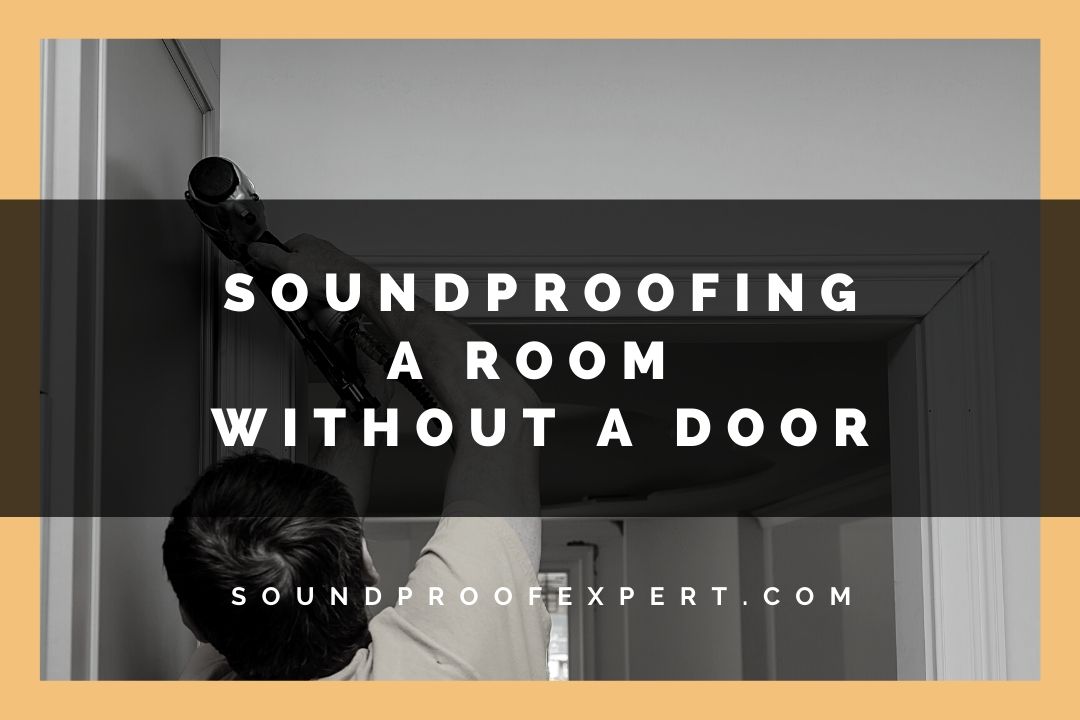
Perhaps you have just moved into a rental and, strangely enough, one of the rooms has no door. Or maybe you are renovating your home and need a temporary sound-blocking solution for your bedroom until you install new doors.
So, how do you soundproof a room without a door? Here are 4 easy methods you can use to soundproof a room without a door:
- Place an acoustic room divider in the empty door frame.
- Create a makeshift door using furniture and other household objects.
- Hang sound-blocking curtains.
- Use acoustic blankets.
You can find more details about these steps in the guide down below. In addition, there are a few other tips and tricks that you can use to improve the sound quality in a room without a door. To learn what these are, keep reading
What You Will Need
Before we get on with the how-to guide, here is a list of the most essential products you will need:
- An acoustic room divider large enough to fill up most of your empty door frame, such as this ReFocus Acoustic Room Divider or this VERSAxRE Versifold
- Acoustical Room Divider (better)
- Noise-blocking curtains, such as the NICETOWN Full Shading Curtains
- This Audimute Isolé Sound Barrier and Absorption Sheet or a similar sound barrier blanket
- Heavy-duty double-sided tape, such as the Gorilla Tough & Clear Mounting Tap
- Clamps like these Boao Suction Cup Clip Clamp Holders
- A high-quality white noise machine like this Adaptive Sound Technologies White Noise Machine
- Industrial ear plugs, such as the Honeywell Howard Leight Foam Earplugs
Place an Acoustic Room Divider in the Empty Door Frame
The first — and most important — thing you need to do is get yourself a high-quality acoustic room divider. However, don’t just buy any room partition. An old-school accordion door or a Japanese-style paper folding screen will not do the trick.
Instead, look for products that were specifically developed to absorb and dampen unwanted sound in office and other shared spaces. You want to get one that fills up as much of your empty door frame as possible. Ideally, the divider should meet the floor directly from end to end.
If there are any gaps between the divider and the door frame, fill them up using whatever soft furnishings you have at hand, such as pillows, cushions, or rolled up rugs.
While an acoustic room divider cannot block outside noises, it can absorb and reduce the echoes and reverberations. That produces a highly-effective muffling effect that could make a world of difference if you need some quiet time.
Create a Makeshift Door Using Furniture and Other Household Objects
If you cannot afford or wait until you get an acoustic room divider, you can try to build a makeshift door using whatever you have lying around. You could also use your homemade barricade to boost the effect of store-bought room dividers.
As a rule of thumb, the more mass you place between you and the outside sounds, the better the sound-blocking effect will be. With this in mind, you could use one or two old mattresses, an upturned dining table, or both.
Make sure to also fill up any remaining gaps using pillows or cushions, as sound can pass through even the tiniest of openings.
You should only use this method if you’re on a tight budget and absolutely need to soundproof your room. Your contraption will probably not look pretty, and you would have to disassemble it every time someone needs to go in or out of the room — but it will do the job.
Hang Sound-Blocking Curtains
Sound-blocking curtains are a great budget alternative to acoustic room dividers. Similarly, they cannot block sound but can do a lot to muffle the bulk of it.
For best results, hang the curtains from the very top of the frame and make sure they reach the floor. If possible, put up two or three layers of curtains to place as much fabric in the path of the sound as possible.
The only downside to this method is that you would need to install curtain rings or hooks on the door frame. That can be time-consuming and requires some technical expertise. It also means that you would have to interfere with the integrity of the frame.
On the other hand, however, curtains dispense with having to move around room dividers or heavy furniture whenever you want to leave the room.
Use Acoustic Blankets
Not willing to drill holes for curtain rods in your door frame? In that case, consider using sound barrier blankets instead. You can quickly and easily hang them in place using nothing but heavy-duty duct tape or strong mounting tape and some clamps.
What’s more, high-quality acoustic blankets have both sound-blocking and sound-absorbing properties — unlike most curtains and room dividers on the market. Just make sure to get the heaviest and thickest blanket you can find.
Extra Tips on Soundproofing a Room Without a Door
Use Soft Furnishings to Your Advantage
If none of the above tips is an option, or even if it is, try to make strategic use of all the soft furnishings you can lay your hands on. Much like curtains and blankets, soft furnishings do not stop sound but rather absorb and dampen it. That could make any offensive noises much more bearable.
So, place as many pillows, cushions, rugs, tapestries, and upholstered furniture around the room as you possibly can. That way, even if outside sound enters the room, it will be muffled quickly.
Get a White Noise Machine
One of the best ways to deal with unwanted noise is to make some yourself. Gentle white noise or quiet background music that you enjoy can mask annoying sounds coming from outside. White noise could also help you relax and fall asleep faster. Therefore, investing in a quality white noise machine might be worth your while.
What’s more, these devices are usually lightweight and portable. That means you could take them with you and use them in places other than your unfortunate doorless room. For instance, a white noise machine could come in handy when traveling or when working in a noisy office.
Buy Earplugs
Last but not least, if nothing else seems to work, get yourself some industrial-grade earplugs. They might feel weird at first, but you will soon get used to them — and they can be extremely effective at blocking noise.
To make sure that they are easy on your ears, buy earplugs made of soft foam or wax that can be molded to fit your ear canal’s distinctive shape. Don’t forget to also disinfect your earplugs before and after each use, and be mindful of ear infections if you end up wearing them for a long time.
Conclusion
Soundproofing a room without a door might seem like mission impossible, but it really isn’t. All you need to do is think outside of the box, roll up your sleeves, and get to work. Some ways to soundproof a doorless room include:
- Placing an acoustic room divider in the doorframe
- Creating a makeshift door
- Hanging sound-blocking curtain
- Using acoustic blankets
That being said, though, there’s only so much you can do to soundproof a room with a gaping door-shaped hole in one of its walls. The tips in this guide are meant to be temporary solutions until you can get a real door.

Great tips. I am setting up an area to record voice overs at home. I’ll be using a hallway that is open on one end. I’m a renter and not going to do any drilling. I think I will combine number one and four in my space.